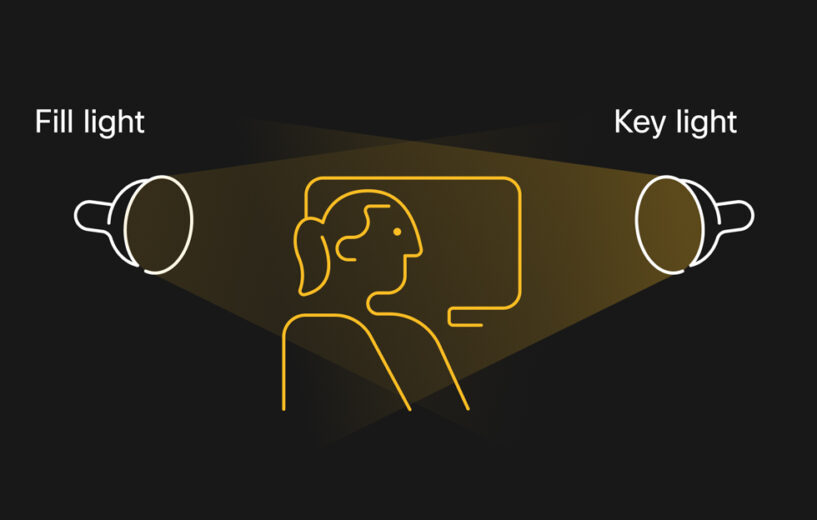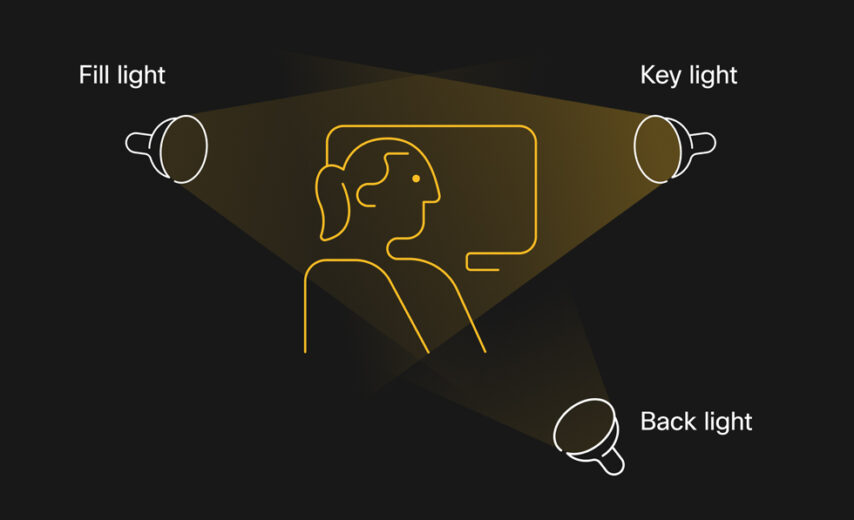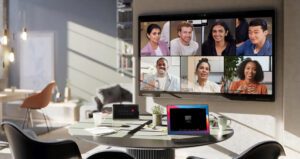Contents: Video conferencing lighting
- What is the best lighting for video conferencing?
- Where should the light be for a video call?
- What kind of lighting is best for video meetings?
- What are the best lighting products for a video conference?
- What is the best lighting for video conferencing on-the-go?
- Good lighting means good communication
The best lighting for video conferencing
You launch your video meeting. A mysterious, shadowy figure appears on the screen. It’s hard to make out exactly who they are. Video conferencing lighting
“Yikes, sorry, gotta fix my lighting,” you say to your colleagues waiting on the call as you fumble to turn on another lamp and try to angle your webcam a bit differently.
Does this scenario sound familiar?
We’ve all likely been in situations where our lighting is less than ideal.
A few too many shadows, light that’s just a bit harsh, or that troublesome backlighting from the otherwise great window in your home office.
Even if you’re generally quite happy with your lighting setup when working from home, there might be one or two tricks you could try to make yourself look even more polished and professional.
We’ve scoured the internet and chatted with our very own creative director—who’s been on hundreds of professional video shoots—to bring you the ultimate guide to taking your video conferencing lighting to the next level.
We’ll cover quick tips for easily optimizing your space on a budget, as well as recommendations for people who want to get really technical and invest in all the gear.
Let’s dive in—or feel free to use the table of contents above to skip to the sections you’re most interested in.
What is the best video conferencing lighting?
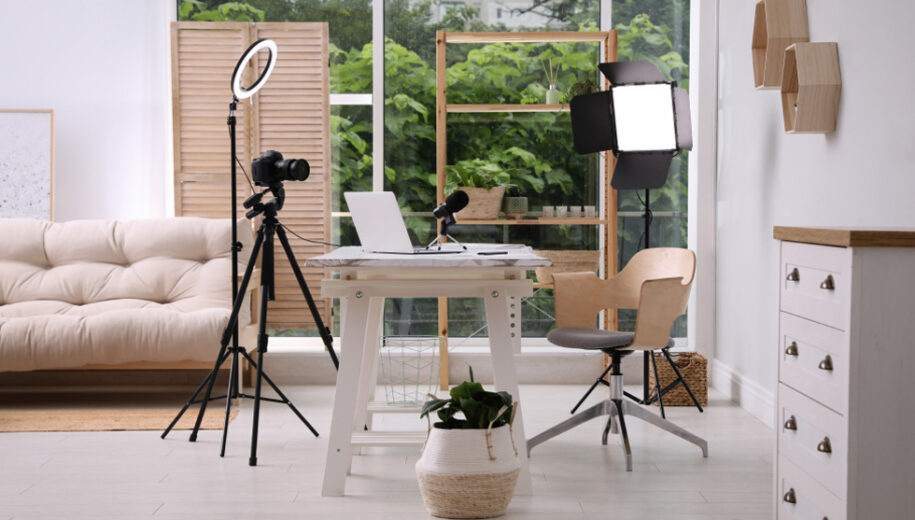
The best lighting for your video meetings really depends on your goals. If you’re a news anchor broadcasting from home, a professional YouTuber, or someone who gives a lot of high-profile presentations, it might make sense to have a glossier, studio-quality lighting setup.
However, most professionals just need a setup that will help them look good on calls and enhance, rather than distract from, what they’re saying.
“We are trying to eliminate all of the distractions, all of the things in the way of you and I talking to each other face to face. Improving your lighting, improving the space around you as best you can is one of those elements that helps do that.” — Josh Gillick, Creative Director, Webex
And with research suggesting that turning on your video during meetings is an important ingredient for successful remote or hybrid collaboration, it’s worth taking the time to make sure you look professional.
After establishing your goals and your budget, there are two primary questions you need to answer when evaluating the best lighting situation for you:
- Where should the light be for your video meeting?
- What kind of lighting is best for your video meetings?
Let’s tackle the where first.
Where should the light be for a video call?
Take some time to evaluate the current lighting in your home workspace, whether that’s a desk in a corner of the living room or a dedicated home office.
Where are the light sources in that room? And where are you positioned in relation to them?
Consider any windows, overhead lights, and lamps in the room.
Avoid backlighting
If you have a window or another source of natural light in the room, make sure it’s not directly behind your desk.
“Avoid bright rear lights,” Gillick cautioned, noting that these will either make your image lower quality or blow out your background.
For this reason, as much as you’d like to have that big, beautiful window in the background of your video meetings, resist putting your desk right in front of it.
“Open up your shades and let the natural light pour in, but don’t let all that light hit your back,” said Becca Farsace, Video Director at The Verge in her great piece on the subject.
Michael Hession, Wirecutter’s head of photography and video, agrees: “The first rule of natural light is don’t have it behind you. If you’re backlit like this, your face is going to look too dark or your background’s going to look too bright.”
Check out Hession’s helpful demo to see backlighting in action—and more tips on how to avoid it.
Put the brightest light source in front of you—or at a 45-degree angle
Experts recommend positioning yourself so your main light source is directly in front of you or at a 45-degree angle to you.
“If you’re lucky enough to have a big window in front of you where you work, that’s great. Most of the work is done for you,” Hession said. “You have this nice big, beautiful light source that will light your face right up.”
To add a bit of interest to the frame, Hession recommends turning so you’re at a 45-degree angle to the window. “This will give you a bit of a shadow on one side of your face. It is a little bit more flattering, it de-emphasizes your blemishes, and just has that little bit of a cinematic touch.”
And what if you don’t have a window in your space or it’s dark outside?
Locate the most powerful light source in your room—a lamp, perhaps, and make sure it’s positioned optimally, following similar guidelines as noted for the window.
If you don’t want to fuss with angles, remember this easy rule of thumb from TechCrunch editor Darrell Etherington’s lighting guide:
“Ideally, you should position yourself so that the source of brightest light is positioned behind your camera (and above it, if possible).”
Be careful with overhead lighting
When arranging your lights, you should also be cautious about overhead lighting like the room’s main light fixture on your ceiling.
Lamps and natural light tend to have better results, said cinematographer Katherine Castro, who has worked on notable films such as “The Equalizer,” “Detroit,” “Ted 2,” and “Spotlight.”
Get fancy with two and three-point lighting
Once you’ve got those basics down, if you want to take things a step further, consider a two-point or three-point lighting arrangement.
What is two-point lighting?
In Gillick’s own office, he’s embraced a two-point lighting scheme.
“I have a big window right next to where I’m sitting. It’s casting light on one side of my face and shaping what I look like,” Gillick explained. “Then I have a lamp with a nice big lampshade on it. I put it over to the other side and I’m shaping the other side of my face.”
These two lights—the key light and fill light, to use the technical terms—work together to prevent either side of his face from being too shadowed, while adding some dimension.
When you go this two-point route, Etherington recommends placing the lights behind or parallel with your webcam, angled toward your face. Also try making one of the lights brighter than the other.
“This will provide a subtle bit of shadow and depth to the lighting on your face, resulting in a more pleasing and professional look,” Etherington noted.
What is three-point lighting?
To get even fancier, add a third light to your space.
“This extra light is used in broadcast interview lighting setups to provide a slight halo effect on the subject, which further helps separate you from the background, and provides a bit more depth and professional look,” Etherington said.
If you want to create this three-point lighting setup, you’ll need the following components:
- Key light: The main light in the setup, the key light should be responsible for about 75% of the light on your face. Put the key light somewhere between a 30 and 45-degree angle to you, rather than directly front of you. If you’re unsure, go with a 45-degree angle which is pretty standard. However, feel free to play around to find a look you like.
- Fill light: Ideally dimmer than the key light, this second light fills the space that’s still unlit, bringing out additional detail. Position the fill light at the same angle as the key light, just on the other side of the camera.
- Back light: This third light is also called a “rim light” or “hair light.” It works to further define the outline of your image so you look three-dimensional. Set your back light behind you, opposite the key light, and out of the frame.
For more guidance on setting up three-point lighting in your space, see this article from the Nashville Film Institute.
Have fun with background or accent lighting
When we start talking about background lights, we’re just having fun at this point. They’re absolutely not essential, but they can add a bit more interest and personality to your space.
“If you want to spice it up a bit, you can try turning lamps on that may be sitting in the background, but just be careful because they might look a little distracting and have a lot of blown out areas,” Hession said. He suggests using smart bulbs so you can control their brightness and ensure they aren’t overpowering.
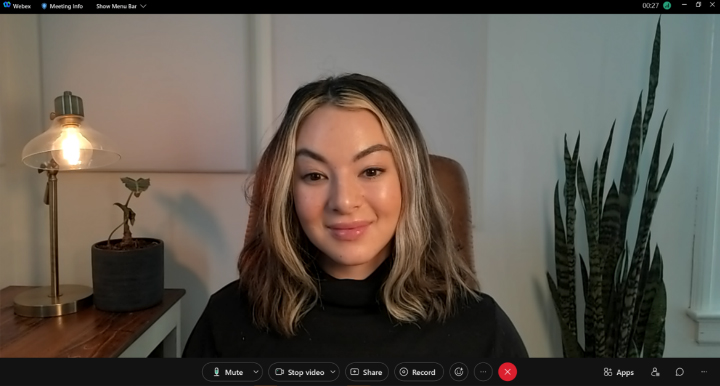
Don’t forget about your screen
As you’re evaluating sources of light in your space, don’t forget about your computer screen and any monitors you might have.
“Your screen can be a large source of light, so adjust your screen brightness, too, especially if you are taking a call without natural light,” Farsace said. “A bright screen can blow the highlights on your face out, making you look more like Casper the Ghost than a video calling champion.”
What kind of lighting is best for video meetings?
Now that we’ve covered where your lights should be, let’s talk about what kind of lights are best.
Diffused light
First, aim for diffused light, rather than concentrated, harsh lighting.
You can achieve diffused light with an inexpensive household lamp: “A simple lamp with a nice lampshade is going to give you diffused light,” Gillick said.
Another easy option for more diffused lighting is to turn the lamp so it bounces off the wall, rather than shining directly on your face.
“If your lamp has any kind of flexibility at all, you can turn it around and face it at the opposing wall. Now that light is bouncing off that wall and onto your face, creating a much more soft, evenly diffused look,” Hession said.
However, you can also invest in fancier lights that have diffuser features, like a ring light or this Lume Cube, an adjustable LED panel light with a softening diffuser.
Color temperature
It’s also important to consider your light’s color temperature.
For those unfamiliar with the term, color temperature is a measure of how warm or cool a light is, measured in kelvins, a unit of temperature measurement in the International System of Units. White light is actually slightly tinted. It appears more orange if it has a lower temperature and bluer with a high temperature. For example, candlelight has a very low kelvin count (about 1000K) and looks very orange. Light from a clear blue sky, on the other hand, has a high kelvin count (about 10,000K) and appears very blue. See this blog from Bucknell University’s Daniel Nienhuis for a nice overview.
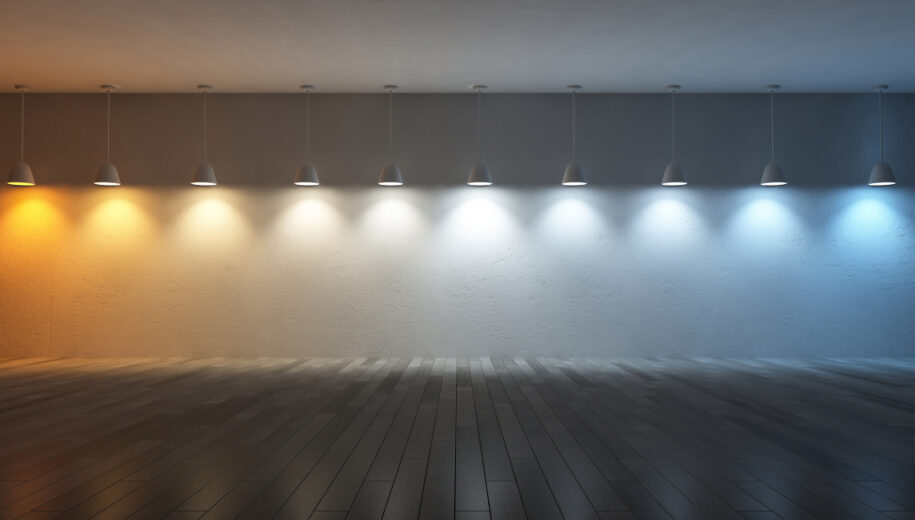
Be cautious when mixing lights with different color temperatures in your office space.
When combining natural light from a window with overhead lights or incandescent lamps, you might end up looking too orange or too blue due to the color temperature difference in the various light sources, Hession noted.
To mitigate this issue, look for LED bulbs that are closer to 6000K. These are ideal for mixing with daylight, said Joshua Dreyfus, a gaffer and chief lighting technician who has worked on major films like “Little Women” and Apple TV’s “Defending Jacob.” (For more lighting tips from Dreyfus, see this Boston Globe article).
On the other hand, if you need warmer light, get LED bulbs that have a color temperature of about 2700K.
To get the right color temperature, you can choose to simply switch out the bulbs in existing lamps you already have, or purchase new lamps with adjustable color temperature, which give you maximum flexibility to change the temperature as needed throughout the day. Adjustable smart bulbs can also provide this flexibility.
Also pay attention to your light’s color-rendering index (CRI), a measure of color accuracy.
Aim for a high CRI to be as close as possible to natural light, advised filmmaker David Tan. Look for lights with a CRI rating that’s near to 100—the CRI of natural light.
Brightness
The brightness of each light also matters.
When we think about measuring the brightness of light, wattage might come to mind first. However, watts actually measure energy and since modern bulbs like LEDs are often low energy, wattage is not always the best indicator of brightness. The Bucknell University blog offers more detail, if you’re interested.
Instead, when buying most types of bulbs (LED, compact fluorescent (CFL), or energy-saving incandescent), pay attention to lumens.
Lumens measure brightness. The more lumens, the brighter the light will be. When replacing a traditional 100-watt incandescent bulb, pick an energy-saving bulb that offers 1600 lumens. If your office space needs a dimmer light, look for a bulb with lower lumens. See this handy fact sheet from the U.S. Department of Energy for more information.
While it’s not necessary, if you want to invest a bit more, choosing smart bulbs with adjustable brightness offers added convenience and flexibility. Some desk lamps, ring lights, and LED panel lights also offer customizable brightness.
What are the best lighting products for a video conference?
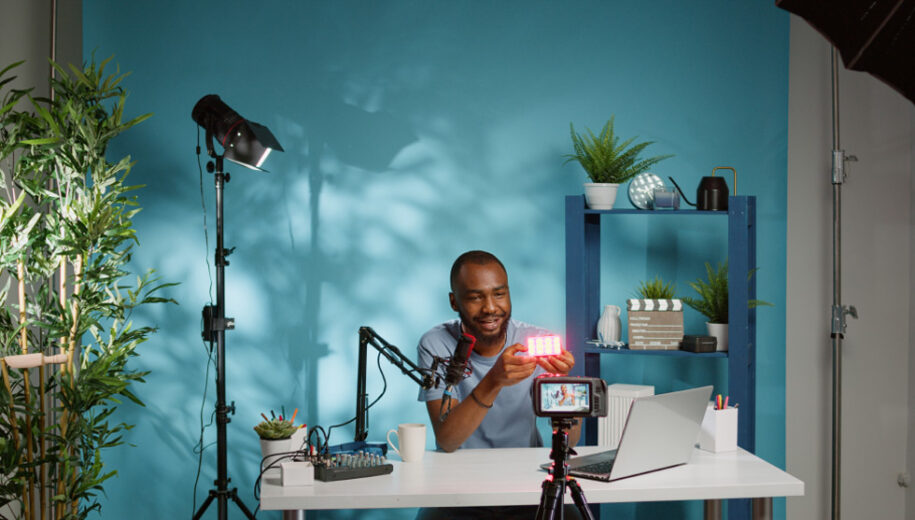
As discussed, you can often make do with the lights you already have at home, rearranging their positioning in your office space as needed.
But you may find that you need a few more lights.
We’ve already mentioned several types of lights you might want to consider, but here’s a concise list of the main ones to think about, as well as a list of features to consider when evaluating possible lights.
What makes a good video light?
When determining which lighting product to invest in, the right suite of features to look for depends on your needs and budget. However, the list below will help you guide your search.
- Adjustable brightness
- Color temperature modes
- Diffuser (or frosted lens)
- Adjustable height, positioning, etc.
- Sturdy mounting (suction cup, clip, etc.)
- Compatibility with tripods and other stands
- Long battery life or other reliable power source (USB plug, etc.)
- Good size (look for something compact if you have a smaller office space, but make sure it’s tall enough to appropriately light your face)
- Portable and not too heavy (if you need to move your office setup frequently)
The best lighting products for video conferencing
As you’re building out your lighting setup, here are a few products to consider.
LED smart bulbs: Smart bulbs have climbed in popularity over the last several years—it’s very likely you already have some in your home. However, if you don’t, switching out your lamp’s existing bulb for a smart bulb can be an easy way to gain more control over the lighting in your space. These Bluetooth-enabled lights often allow you to adjust the color and brightness of the lights to suit your needs.
And, as an added bonus, you can control them by voice or via an app on your phone. No more frantically jumping up before a video call to adjust your light.
There are many brands and types of smart bulbs to choose from, so look for a light that’s as customizable as possible, making sure it can provide the color temperature and brightness you need.
LED desk lamps: Another great addition to your lighting setup might be an LED desk lamp with adjustable color and brightness settings. Also look for one with a flexible arm so that you can easily tweak the light’s position without moving the entire lamp.
Ring lights: A favorite of social media influencers, ring lights can also be a great asset for your video calls. There are many varieties out there, from ones that clip onto your computer to ones that come with an adjustable tripod.
A model with a stand offers the most flexibility in terms of positioning, but depending on your budget and space, pick the ring light that works best for you.
One caution: Ring lights tend to reflect in your eyes and glasses, creating a mildly sci-fi look that can distract others during your video meeting. To avoid that bright white ring in your pupils or glasses, Tan recommends moving the light farther from your face to distribute the light more. Also try angling the light slightly to the side or above you.
Gillick also warns against putting the ring light right in front of you as this might wash you out and flatten your features. Take some time to move the light around and find the most flattering position.
LED panel light: LED panel lights are another great way to add another light source to your space, in lieu of or in addition to a desk lamp.
Similar to ring lights there are a variety of models out there. Look for ones with adjustable color and brightness. For maximum flexibility, pick a model that can connect to Wi-Fi so you can control it from your computer or smartphone. Also consider the stand. Is it adjustable? Sturdy? Can the panel light detach in case you want to switch it to a different stand?
And how is the light powered? Does it come with a USB charging port? Does it have a substantial battery life so you can use it on-the-go, if needed?
Panel lights also range in size, so consider the size of your space and your lighting needs when purchasing. For a high-quality smaller option, check out this Panel Mini from Lume Cube.
Full lighting kit: If you really want to get serious about lighting, you might consider investing in a full lighting kit. Some companies sell everything you need for a two-point lighting setup in a single package.
You can also choose to build your own. TechCrunch’s Etherington shares his favorite products in this article. And for another real-world example, watch the video below to see the tools Cisco collaboration specialist John Seaton chose for his home office.
What else do I need for quality video conferencing lighting?
In addition to the right lights, you may want to invest in a few other tools that will impact your lighting.
Curtains: If your space has natural light, make sure you have some curtains or other window coverings that allow you to control the light coming in.
Tripod: When you choose to go the ring light or panel light route, it might also help to get a tripod to attach it to. Even if the light comes with a default tripod or stand, you might find that you want a different size tripod to accommodate your needs.
Look for an adjustable tripod that can extend to multiple heights.
High-quality webcam: Getting your lighting right in your space is only part of the battle. If you have a poor-quality webcam, you may still not come across great on camera. The default camera on your laptop may not cut it.
Look for a high-quality external webcam that supports excellent video in various lighting conditions.
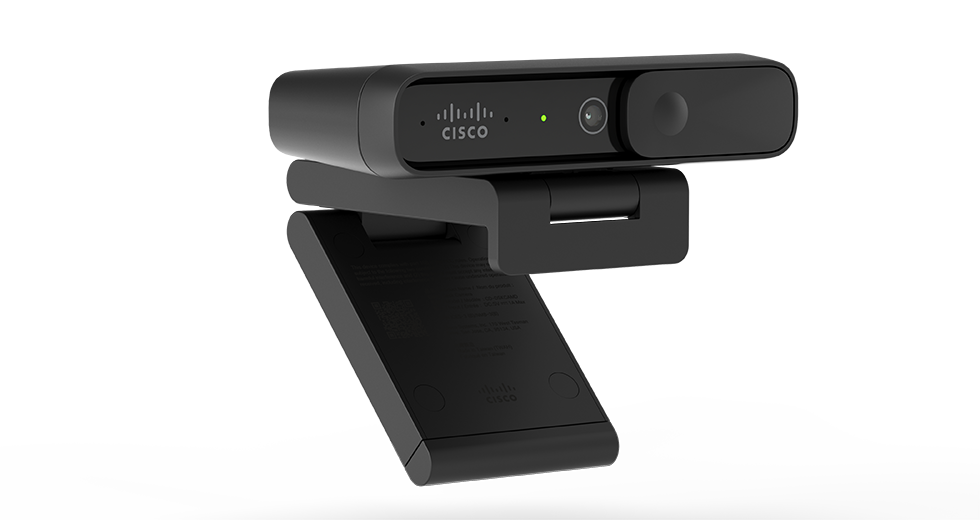
Top-notch video conferencing software: Coupled with a great lighting setup and a high-quality webcam, you’ll also want top-notch video conferencing software with features like background noise removal, real-time translation, etc.
Take advantage of the various features your video conferencing software offers to make sure your lighting is just right.
For example, when joining meetings from the Webex App, you can preview how you look before you enter the meeting. A few minutes before the meeting, take a moment to check this video preview and make any lighting adjustments necessary.
If you’re using a virtual background, consider how your lighting interacts with that. For example, if your virtual background pictures a nice office scene with cooler lighting, you’ll look a bit odd if the lighting in your actual office and therefore on your face is warmer. Try to pick a virtual background that matches the lighting in your space.
You can also let Webex adjust camera brightness automatically or opt to do so manually if you want to fine tune it even more. In the “manual” mode, you can use a slider to increase or decrease the brightness of your image.
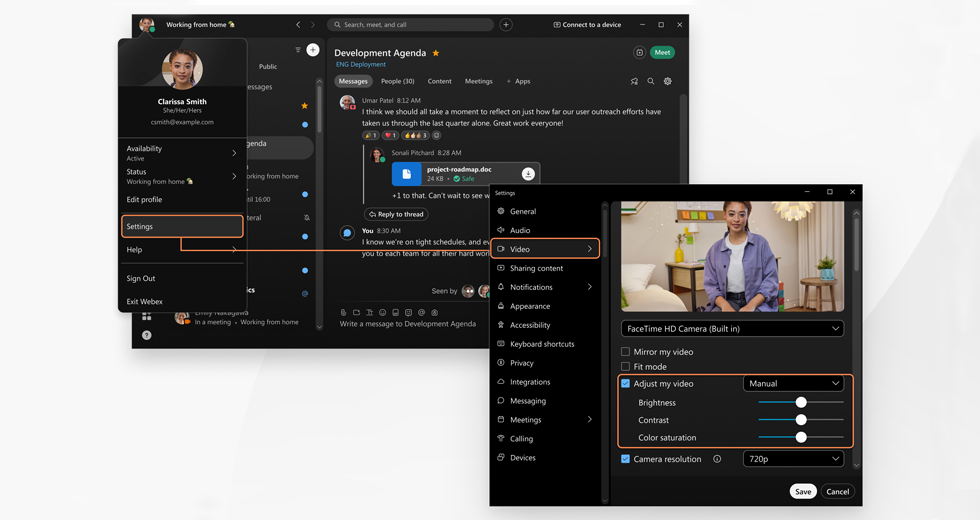
Office décor: Since you’re going to all the trouble to light your workspace well, the space itself should also communicate professionalism and share a bit of your personality.
“If you have an area you can own in your home that is for video conferencing, dress it,” Gillick said. “Make it something that tells people about you.”
Put thought into the placement of any furniture and consider adding a few pieces of art or other decor that give the space some personality and interest. While you definitely don’t want to overwhelm the space with too much distracting clutter, a couple well-placed accessories can be a powerful addition.
In Gillick’s own home office , he’s added some artwork to his back wall, reflecting his love of painting and photography. A couch and lamp complete the look.
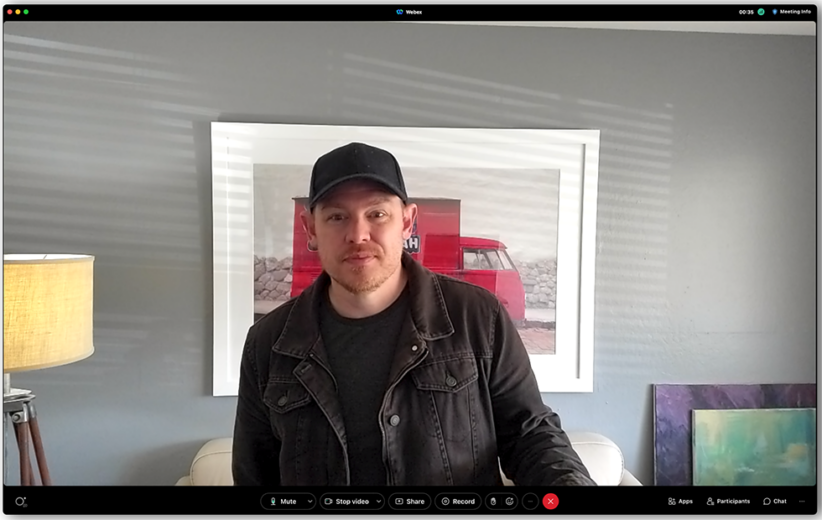
If you don’t have a large piece of art you want to display, another great strategy is to place some shelves behind you and fill them with books, plants, and other meaningful objects. Cameron Conaway, Webex’s Head of Content Marketing, went this route in his workspace.
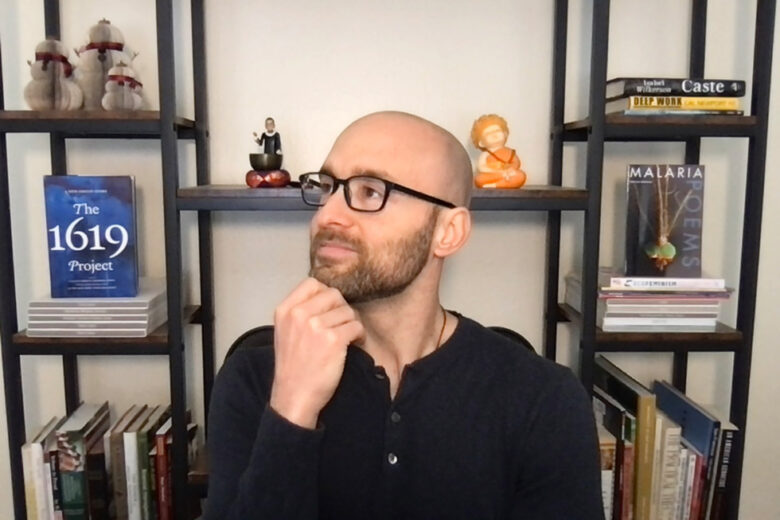
What is the best on-the-go video conferencing lighting?
Once you’ve fine-tuned the lighting setup in your home office space, it’s time to think about how to find optimal lighting when you’re working from another location like a coffee shop or a coworking space—local health regulations permitting, of course.
The same principles we’ve discussed throughout this article still apply. Where the light is matters, as does the kind of light.
Instead of just plunking down at any open table in your favorite coffee shop, Gillick encourages being choosy about where you sit, if you can.
Try to position yourself so a window is at your shoulder and the light is hitting you from the side, Gillick suggested. Also make sure there aren’t any big bright lights behind you.
If you’re up for bringing a bit of portable lighting gear with you, Gillick recommends a battery-powered light with a small tripod.
However, if that’s not a good fit for you, just being careful about where you sit in relation to the existing light sources in the room can go a long way.
Whenever you’re in a new space, utilize the preview feature in your video conferencing platform to check how you look and make any adjustments before the call.
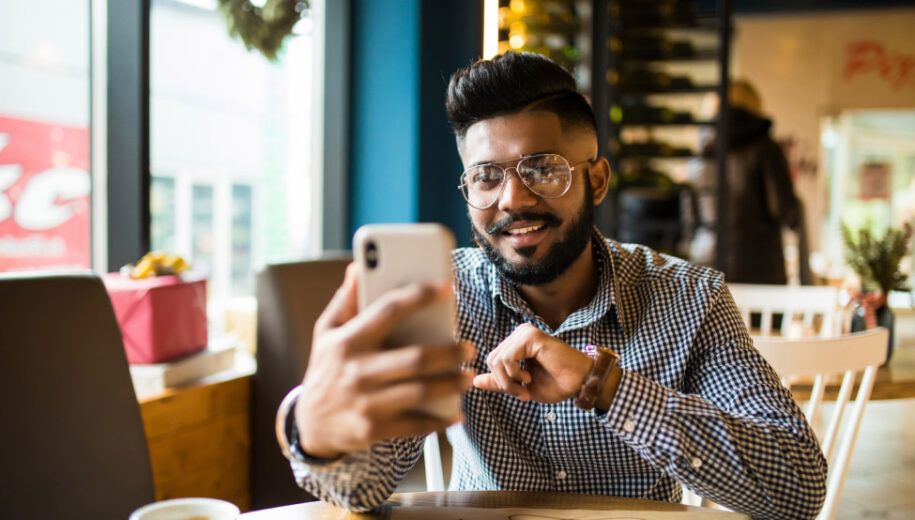
Good lighting means good communication
Hopefully, you now feel empowered to create the lighting setup that works best for you, whether that means simply tweaking the position of a desk lamp you already have or investing in a full, professional lighting kit.
Whatever steps you take, don’t lose sight of your overall goal: communicating well. Good lighting is just one of the many ways you can enhance your communication and connect with colleagues and clients. A well-lit space helps remove distractions and keeps the attention on you and what you’re saying during that major presentation or important chat with your boss.
So here’s to great lighting and even better communication and collaboration!
To learn more about how Webex can take your collaboration to the next level with smarter video conferencing, get in touch with us.
Related reading:

